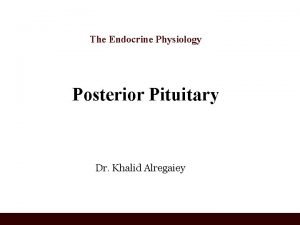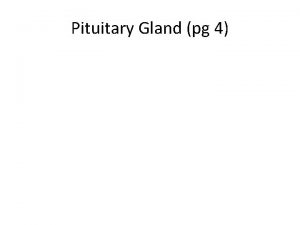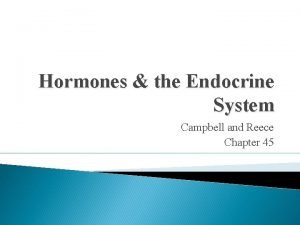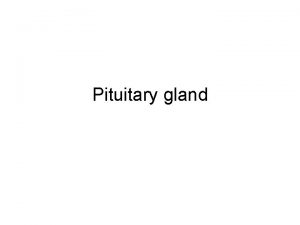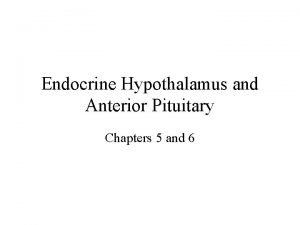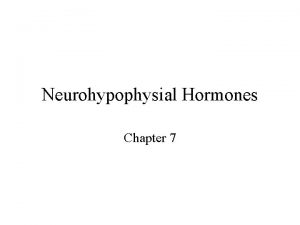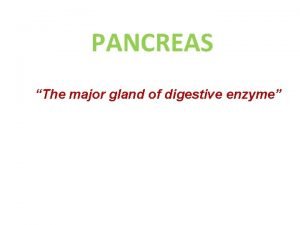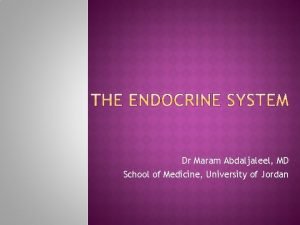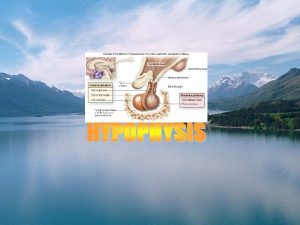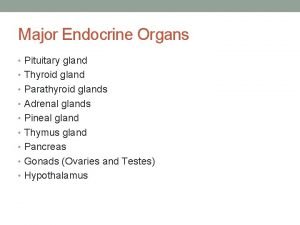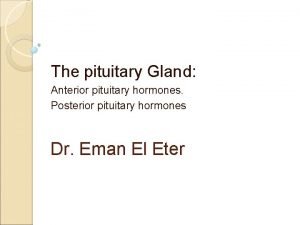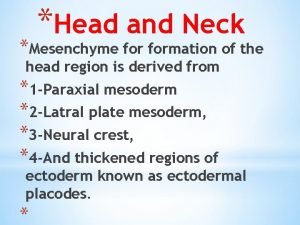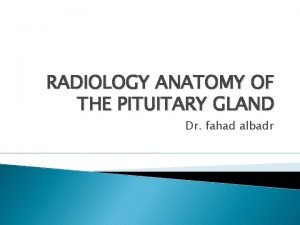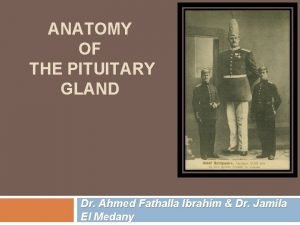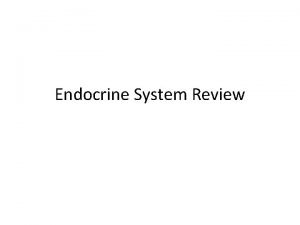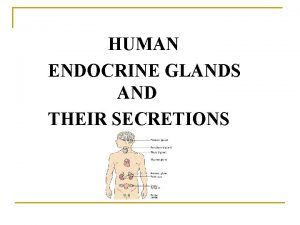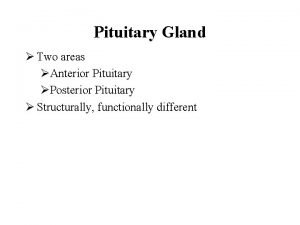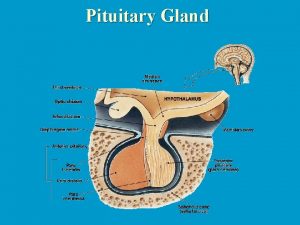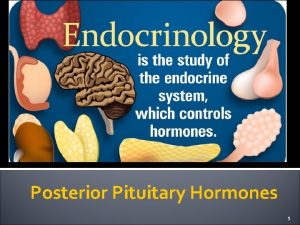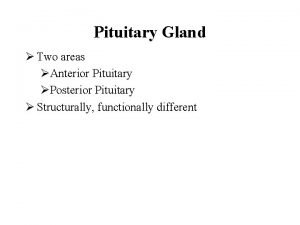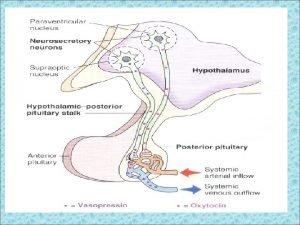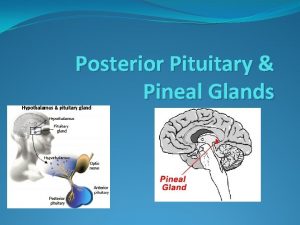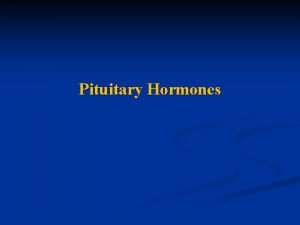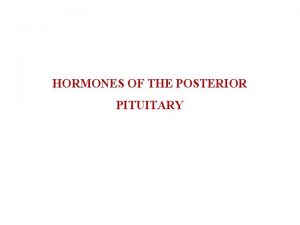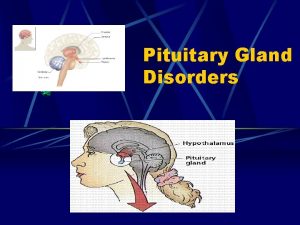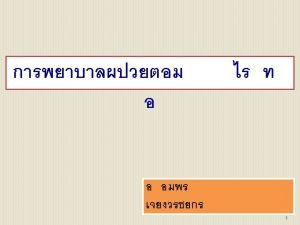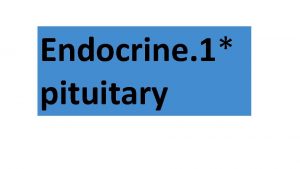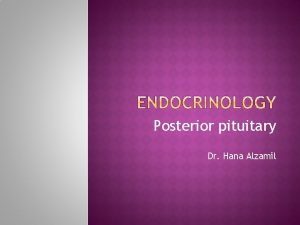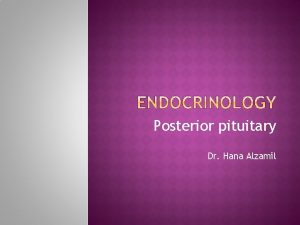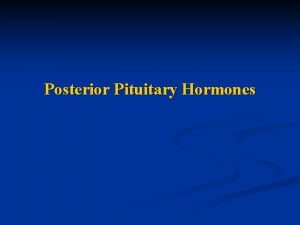HORMONES OF THE POSTERIOR PITUITARY HORMONES OF THE



![A. Oxytocin • Oxytocin [ok-se-TOE-sin] is used in obstetrics to stimulate uterine contraction and A. Oxytocin • Oxytocin [ok-se-TOE-sin] is used in obstetrics to stimulate uterine contraction and](https://slidetodoc.com/presentation_image_h/0dcf32d0b820b10ac6f6beca59226243/image-4.jpg)
![B. Vasopressin • Vasopressin [vas-oh-PRESS-in] (antidiuretic hormone (ADH)) is structurally related to oxytocin. • B. Vasopressin • Vasopressin [vas-oh-PRESS-in] (antidiuretic hormone (ADH)) is structurally related to oxytocin. •](https://slidetodoc.com/presentation_image_h/0dcf32d0b820b10ac6f6beca59226243/image-5.jpg)
![• Desmopressin [des-moe- PRESS-in], an analog of vasopressin, has minimal activity at the • Desmopressin [des-moe- PRESS-in], an analog of vasopressin, has minimal activity at the](https://slidetodoc.com/presentation_image_h/0dcf32d0b820b10ac6f6beca59226243/image-6.jpg)









![• • 2. Inhibition of thyroid hormone synthesis: The thioamides, propylthiouracil [proe-pil-thye-oh-YOOR-ah-sil] (PTU) • • 2. Inhibition of thyroid hormone synthesis: The thioamides, propylthiouracil [proe-pil-thye-oh-YOOR-ah-sil] (PTU)](https://slidetodoc.com/presentation_image_h/0dcf32d0b820b10ac6f6beca59226243/image-16.jpg)




- Slides: 20

HORMONES OF THE POSTERIOR PITUITARY

HORMONES OF THE POSTERIOR PITUITARY • In contrast to the hormones of the anterior lobe of the pituitary, those of the posterior lobe, vasopressin and oxytocin, are not regulated by releasing hormones. • They are synthesized in the hypothalamus, transported to the posterior pituitary, and released in response to specific physiologic signals, such as high plasma osmolarity or parturition. • Both hormones are administered intravenously and have very short half-lives.

![A Oxytocin Oxytocin okseTOEsin is used in obstetrics to stimulate uterine contraction and A. Oxytocin • Oxytocin [ok-se-TOE-sin] is used in obstetrics to stimulate uterine contraction and](https://slidetodoc.com/presentation_image_h/0dcf32d0b820b10ac6f6beca59226243/image-4.jpg)
A. Oxytocin • Oxytocin [ok-se-TOE-sin] is used in obstetrics to stimulate uterine contraction and induce labor. • Oxytocin also causes milk ejection by contracting the myoepithelial cells around the mammary alveoli. • Although toxicities are uncommon when the drug is used properly, hypertension, uterine rupture, water retention, and fetal death have been reported. • Its antidiuretic and pressor activities are much less pronounced than those of vasopressin
![B Vasopressin Vasopressin vasohPRESSin antidiuretic hormone ADH is structurally related to oxytocin B. Vasopressin • Vasopressin [vas-oh-PRESS-in] (antidiuretic hormone (ADH)) is structurally related to oxytocin. •](https://slidetodoc.com/presentation_image_h/0dcf32d0b820b10ac6f6beca59226243/image-5.jpg)
B. Vasopressin • Vasopressin [vas-oh-PRESS-in] (antidiuretic hormone (ADH)) is structurally related to oxytocin. • Vasopressin has both antidiuretic and vasopressor effects. • In the kidney, it binds to the V 2 receptor to increase water permeability and reabsorption in the collecting tubules. • The major use of vasopressin is to treat diabetes insipidus. • It also finds use in the management of cardiac arrest and in controlling bleeding due to esophageal varices. • Other effects of vasopressin are mediated by the V 1 receptor, which is found in liver, vascular smooth muscle (where it causes constriction), and other tissues. • The major toxicities of vasopressin are water intoxication and hyponatremia. Abdominal pain, tremor, and vertigo can also occur.
![Desmopressin desmoe PRESSin an analog of vasopressin has minimal activity at the • Desmopressin [des-moe- PRESS-in], an analog of vasopressin, has minimal activity at the](https://slidetodoc.com/presentation_image_h/0dcf32d0b820b10ac6f6beca59226243/image-6.jpg)
• Desmopressin [des-moe- PRESS-in], an analog of vasopressin, has minimal activity at the V 1 receptor, making it largely free of pressor effects. • This analog is longer acting than vasopressin and is preferred for the treatment of diabetes insipidus and nocturnal enuresis. • For these indications, desmopressin may be administered intranasally or orally. • The nasal spray should not be used for enuresis due to reports of seizures in children using this formulation. • Local irritation may occur with the nasal spray.

Thyroid Gland • The thyroid gland facilitates normal growth and maturation by maintaining a level of metabolism in the tissues that is optimal for their normal function. • The two major thyroid hormones are triiodothyronine (T 3; the most active form) and thyroxine (T 4). • Hypothyroidism: inadequate secretion of thyroid hormone results in bradycardia, poor resistance to cold, and mental and physical slowing. • In children, this can cause mental retardation and dwarfism. • Hyperthyroidism: excess secretion of thyroid hormones can cause tachycardia and cardiac arrhythmias, body wasting, nervousness, tremor, and heat intolerance.

• • Thyroid hormone synthesis and secretion The thyroid gland is made up of multiple follicles that consist of a single layer of epithelial cells surrounding a lumen filled with thyroglobulin, which is the storage form of thyroid hormone. Thyroid function is controlled by thyroid-stimulating hormone (TSH; thyrotropin), which is synthesized by the anterior pituitary TSH generation is governed by the hypothalamic thyrotropin-releasing hormone (TRH). TSH action is mediated by c. AMP and leads to stimulation of iodide (I−) uptake by the thyroid gland. Oxidation to iodine (I 2) by a peroxidase is followed by iodination of tyrosines on thyroglobulin. Antibodies to thyroid peroxidase are diagnostic for Hashimoto thyroiditis, a common cause of hypothyroidism. Condensation of two diiodotyrosine residues gives rise to T 4, whereas condensation of a monoiodotyrosine residue with a diiodotyrosine residue generates T 3. The hormones are released following proteolytic cleavage of the thyroglobulin.

Biosynthesis of thyroid hormones

Mechanism of action • Most of the hormone (T 3 and T 4) is bound to thyroxine-binding globulin in the plasma. • The hormones must dissociate from thyroxine-binding globulin prior to entry into cells. • In the cell, T 4 is enzymatically deiodinated to T 3, which enters the nucleus and attaches to specific receptors. • The activation of these receptors promotes the formation of RNA and subsequent protein synthesis, which is responsible for the effects of T 4.

Pharmacokinetics • Both T 4 and T 3 are absorbed after oral administration. ü Food, calcium preparations, and aluminum-containing antacids can decrease the absorption of T 4. ü Deiodination is the major route of metabolism of T 4. ü T 3 also undergoes sequential deiodination. • The hormones are also metabolized via conjugation with glucuronides and sulfates and excreted into the bile

Treatment of hypothyroidism • Hypothyroidism usually results from autoimmune destruction of the gland or the peroxidase and is diagnosed by elevated TSH. • Levothyroxine (T 4) [leh-vo-thye-ROK-sin] is preferred over T 3 (liothyronine or T 3/T 4 combination products (liotrix) for the treatment of hypothyroidism. • Levothyroxine (T 4) is better tolerated than T 3 preparations and has a longer half-life. • Levothyroxine is dosed once daily, and steady state is achieved in 6 to 8 weeks. • Toxicity is directly related to T 4 levels and manifests as nervousness, palpitations and tachycardia, heat intolerance, and unexplained weight loss. • Drugs that induce the cytochrome P 450 enzymes, such as phenytoin, rifampin, and phenobarbital, accelerate metabolism of the thyroid hormones and may decrease the effectiveness


• • • Treatment of hyperthyroidism (thyrotoxicosis) Graves disease, an autoimmune disease that affects the thyroid, is the most common cause of hyperthyroidism. In these situations, TSH levels are reduced due to negative feedback. Feedback inhibition of TRH occurs with high levels of circulating thyroid hormone, which, in turn, decreases secretion of TSH. The goal of therapy is to decrease synthesis and/or release of additional hormone. This can be accomplished by removing part or all of the thyroid gland, by inhibiting synthesis of the hormones, or by blocking release of the hormones from the follicle.

1. Removal of part or all of the thyroid: • This can be accomplished either surgically or by destruction of the gland with radioactive iodine (131 I), which is selectively taken up by the thyroid follicular cells. • Most patients become hypothyroid as a result of this drug and require treatment with levothyroxine.
![2 Inhibition of thyroid hormone synthesis The thioamides propylthiouracil proepilthyeohYOORahsil PTU • • 2. Inhibition of thyroid hormone synthesis: The thioamides, propylthiouracil [proe-pil-thye-oh-YOOR-ah-sil] (PTU)](https://slidetodoc.com/presentation_image_h/0dcf32d0b820b10ac6f6beca59226243/image-16.jpg)
• • 2. Inhibition of thyroid hormone synthesis: The thioamides, propylthiouracil [proe-pil-thye-oh-YOOR-ah-sil] (PTU) and methimazole [me-THIMah-zole], are concentrated in the thyroid, where they inhibit both the oxidative processes required for iodination of tyrosyl groups and the condensation (coupling) of iodotyrosines to form T 3 and T 4 propylthiouracil (PTU) also blocks the peripheral conversion of T 4 to T 3. These drugs have no effect on thyroglobulin already stored inthe gland. Therefore, clinical effects of these drugs may be delayed until thyroglobulin stores are depleted.

• Methimazole is preferred over PTU because it has a longer half-life, allowing for once-daily dosing, and a lower incidence of adverse effects. • PTU is recommended during the first trimester of pregnancy due to a greater risk of teratogenic effects with methimazole. • PTU has been associated with hepatotoxicity and, rarely, agranulocytosis.

Biosynthesis of thyroid hormones

3. Blockade of hormone release: • A pharmacologic dose of iodide inhibits the iodination of tyrosines (“Wolff-Chaikoff effect”), but this effect lasts only a few days. • More importantly, iodide inhibits the release of thyroid hormones from thyroglobulin by mechanisms not yet understood. Iodide is employed to treat thyroid storm or prior to surgery, because it decreases the vascularity of the thyroid gland. • Iodide is not useful for long-term therapy, because thyroid ceases to respond to the drug after a few weeks. Iodide is administered orally. • Adverse effects include sore mouth and throat, swelling of the tongue or larynx, rashes, ulcerations of mucous membranes, and a metallic taste in the mouth.

Thyroid storm: • Thyroid storm presents with extreme symptoms of hyperthyroidism. • The treatment of thyroid storm is the same as that for hyperthyroidism, except that the drugs are given in higher doses and more frequently. • β-blockers, such as metoprolol or propranolol, are effective in blunting the widespread sympathetic stimulation that occurs in hyperthyroidism.
 Posterior pituitary hormones
Posterior pituitary hormones Pituitary gland hormones
Pituitary gland hormones Parathyroid gland chief cell
Parathyroid gland chief cell Neurotransimitters
Neurotransimitters Embryonic development of pituitary gland
Embryonic development of pituitary gland The embryonic origin of the anterior pituitary gland is
The embryonic origin of the anterior pituitary gland is Difference between anterior and posterior pituitary
Difference between anterior and posterior pituitary Difference between anterior and posterior pituitary
Difference between anterior and posterior pituitary Where is kidney pain felt diagram
Where is kidney pain felt diagram Posterior pituitary
Posterior pituitary Posterior pituitary blood supply
Posterior pituitary blood supply Anterior pituitary
Anterior pituitary Positive feedback mechanism
Positive feedback mechanism Development of tongue
Development of tongue Hypersecretion of prolactin
Hypersecretion of prolactin Cavernous sinus
Cavernous sinus Anatomical relations of pituitary gland
Anatomical relations of pituitary gland What is the name
What is the name N
N Anterior pituitary gland
Anterior pituitary gland Ceolocant
Ceolocant
